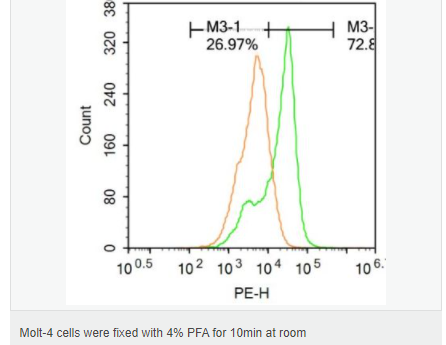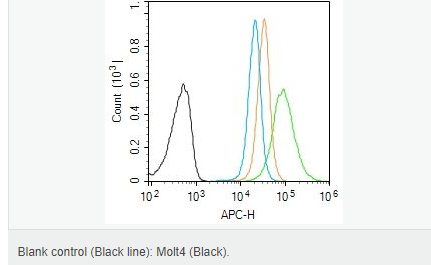

货号
产品规格
售价
备注
BN41223R-100ul
100ul
¥2360.00
交叉反应:Human(predicted:Mouse,Rat,Dog,Pig,Cow,Horse,Rabbit) 推荐应用:WB,IHC-P,IHC-F,IF,Flow-Cyt,ELISA
BN41223R-200ul
200ul
¥3490.00
交叉反应:Human(predicted:Mouse,Rat,Dog,Pig,Cow,Horse,Rabbit) 推荐应用:WB,IHC-P,IHC-F,IF,Flow-Cyt,ELISA
产品描述
| 英文名称 | SDHB |
| 中文名称 | 铬细胞瘤患者抑癌基因SDHB抗体 |
| 别 名 | succinate dehydrogenase complex,subunit B; mitochondrial; DHSB_HUMAN; Ip; Iron sulfur subunit; Iron sulfur subunit of complex II; Iron-sulfur subunit of complex II; PGL 4; PGL4; SDH 1; SDH; SDH1; SDH2; SdhB; SDHIP; Succinate dehydrogenase [ubiquinone] iron sulfur protein mitochondrial; Succinate dehydrogenase [ubiquinone] iron-sulfur subunit; Succinate Dehydrogenase 1 Iron Sulfur Subunit; Succinate dehydrogenase complex subunit B iron sulfur; Succinate Dehydrogenase Complex Subunit B Iron Sulfur Protein; Succinate dehydrogenase iron sulfur protein. |
| 研究领域 | 肿瘤 细胞生物 信号转导 |
| 抗体来源 | Rabbit |
| 克隆类型 | Polyclonal |
| 交叉反应 | Human, (predicted: Mouse, Rat, Dog, Pig, Cow, Horse, Rabbit, ) |
| 产品应用 | WB=1:500-2000 ELISA=1:5000-10000 IHC-P=1:100-500 IHC-F=1:100-500 Flow-Cyt=1ug/Test IF=1:100-500 (石蜡切片需做抗原修复) not yet tested in other applications. optimal dilutions/concentrations should be determined by the end user. |
| 分 子 量 | 32kDa |
| 细胞定位 | 细胞浆 细胞膜 |
| 性 状 | Liquid |
| 浓 度 | 1mg/ml |
| 免 疫 原 | KLH conjugated synthetic peptide derived from human SDHB:201-280/280 |
| 亚 型 | IgG |
| 纯化方法 | affinity purified by Protein A |
| 储 存 液 | 0.01M TBS(pH7.4) with 1% BSA, 0.03% Proclin300 and 50% Glycerol. |
| 保存条件 | Shipped at 4℃. Store at -20 °C for one year. Avoid repeated freeze/thaw cycles. |
| PubMed | PubMed |
| 产品介绍 | Iron-sulfur protein (IP) subunit of succinate dehydrogenase (SDH) that is involved in complex II of the mitochondrial electron transport chain and is responsible for transferring electrons from succinate to ubiquinone (coenzyme Q). Function: Iron-sulfur protein (IP) subunit of succinate dehydrogenase (SDH) that is involved in complex II of the mitochondrial electron transport chain and is responsible for transferring electrons from succinate to ubiquinone (coenzyme Q). Subunit: Component of complex II composed of four subunits: the flavoprotein (FP) SDHA, iron-sulfur protein (IP) SDHB, and a cytochrome b560 composed of SDHC and SDHD. Subcellular Location: Mitochondrion inner membrane; Peripheral membrane protein; Matrix side. DISEASE: Defects in SDHB are a cause of susceptibility to pheochromocytoma (PCC) [MIM:171300]. A catecholamine-producing tumor of chromaffin tissue of the adrenal medulla or sympathetic paraganglia. The cardinal symptom, reflecting the increased secretion of epinephrine and norepinephrine, is hypertension, which may be persistent or intermittent. Defects in SDHB are the cause of paragangliomas type 4 (PGL4) [MIM:115310]. A neural crest tumor usually derived from the chromoreceptor tissue of a paraganglion. Paragangliomas are most commonly located in the head and neck region, specifically at the carotid bifurcation, the jugular foramen, the vagal nerve, and in the middle ear. Defects in SDHB are a cause of paraganglioma and gastric stromal sarcoma (PGGSS) [MIM:606864]; also called Carney-Stratakis syndrome. Gastrointestinal stromal tumors may be sporadic or inherited in an autosomal dominant manner, alone or as a component of a syndrome associated with other tumors, such as in the context of neurofibromatosis type 1 (NF1). Patients have both gastrointestinal stromal tumors and paragangliomas. Susceptibility to the tumors was inherited in an apparently autosomal dominant manner, with incomplete penetrance. Similarity: Belongs to the succinate dehydrogenase/fumarate reductase iron-sulfur protein family. Contains 1 2Fe-2S ferredoxin-type domain. Contains 1 4Fe-4S ferredoxin-type domain. SWISS: P21912 Gene ID: 6390 Database links: Entrez Gene: 6390 Human Entrez Gene: 67680 Mouse Omim: 185470 Human SwissProt: P21912 Human SwissProt: Q9CQA3 Mouse Unigene: 465924 Human Unigene: 246965 Mouse Unigene: 3902 Rat Important Note: This product as supplied is intended for research use only, not for use in human, therapeutic or diagnostic applications |

